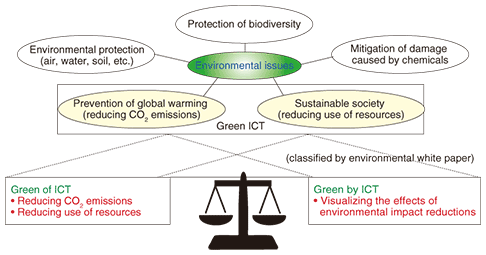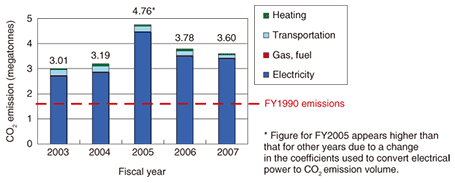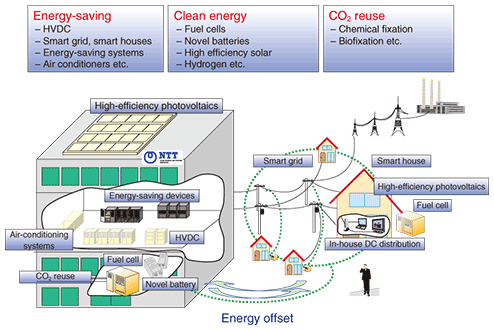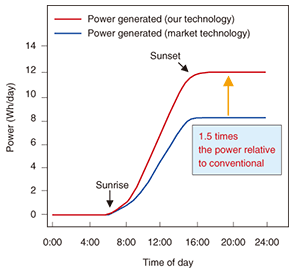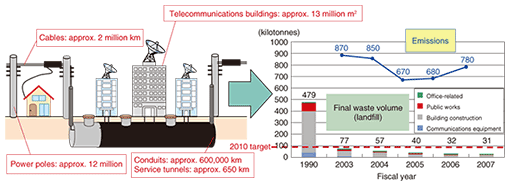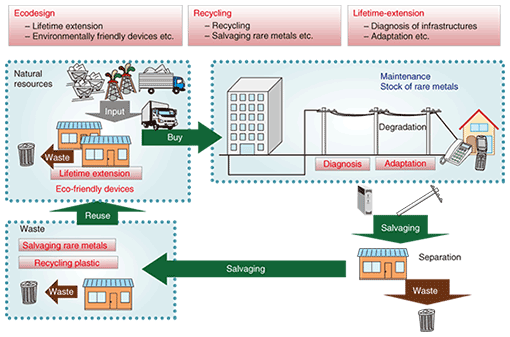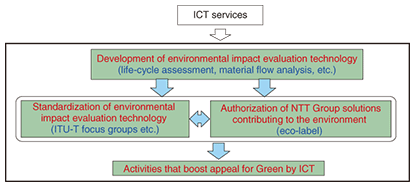 |
|||||||||||||||||||||||||||||||||||
|
|
|||||||||||||||||||||||||||||||||||
|
Special Feature: NTT Group R&D for Reducing Environmental Load Vol. 7, No. 10, pp. 1–8, Oct. 2009. https://doi.org/10.53829/ntr200910sf1 Energy and Environment R&D Toward Environmental Impact ReductionAbstractThis article describes research and development strategies at the NTT Energy and Environment Systems Laboratories toward reducing the environmental impact. It classifies research on energy and environment systems into five fields and, among these, focuses on two important activities, namely reducing CO2 emissions and establishing a sustainable society, which are strongly related to information and communications technology (ICT), which is NTT’s business area. Ways of evaluating ICT’s contributions to society are also discussed.
1. Introduction2009 is the beginning of the first commitment period of the 1997 Kyoto Protocol. Japan and other ratifying countries have begun initiatives to achieve their goals. Other efforts to reduce global warming, such as discussion of post-Kyoto protocols like COP15, are also becoming more active. Various other initiatives related to environmental issues are also proceeding, such as promotion of the 3Rs (reduce, reuse, and recycle) based on the Japanese Ministry of the Environment’s “Basic Act for Establishing a Sound Material-Cycle Society,” established in 2000. These activities reflect society’s increasing concern for the global environment and the demands for companies to consider environmental issues when managing their operations. With the occurrence of actions such as the announcement of the “New Energy Deal” policy in the USA, there are expectations for new research and development (R&D) and market expansion opportunities for environment and energy-related technology. As shown in Fig. 1, environmental issues can be divided into five areas: prevention of global warming, sustainable society, environmental protection, protection of biodiversity, and mitigation of damage caused by chemical substances. Of these, the environmental impact reduction areas most closely related to the NTT Group’s overall business activities involve reducing global warming and creating a sustainable society, which mainly mean reducing of CO2 emissions and the use of resources.
Nowadays, the words Green ICT (or Green IT) are often used to explain the relationships between these types of environmental issues and information and communications technology (ICT) or information technology (IT). Green ICT can be regarded as having two sides: reducing the environmental impact caused by ICT itself (Green of ICT) and reducing the environmental impact of other factors by utilizing ICT (Green by ICT). It is important to take their balance into consideration in trying to solve global environmental issues [1]. Green of ICT will require reductions in energy consumption and improvements in the energy efficiency of telecommunications equipment in order to reduce CO2 emissions. Moreover, since many kinds of materials are used in telecommunications devices and the infrastructure, such as plastics, metals, concrete, and rare metals, these must be used efficiently and in smaller amounts at the manufacturing stage in order to achieve a sustainable society. Promoting the reuse of raw materials and extending the lifetime of products are the keys to resource conservation. On the other hand, Green by ICT needs a method of quantifying (visualizing) the effects of environmental impact reductions achieved by ICT services. The final goal here is to establish worldwide awareness of the benefits of ICT services. In light of this, R&D in the energy and environment areas of the ICT field will need to achieve a good balance between technology that contributes to a smaller environmental impact of ICT itself and technology that utilizes ICT to evaluate the environmental impact reductions of society as a whole. 2. Green of ICT activities2.1 R&D towards CO2 emissions reductionsVarious activities for achieving a low-carbon society are now starting and the number is increasing day by day. They include the introduction of emission rights in accordance with the Kyoto Protocol, Post-Kyoto international activities, and national/local regulatory activities. Moreover, activities toward the further step of a carbon-free society are beginning. Yearly changes in NTT Group activities are shown in Fig. 2. CO2 emissions due to business activities are expected to meet the basic unit criteria set as an objective for the Group, but emissions are increasing and are currently at roughly double the 1990 levels (approx. 0.3% of the total for Japan). NTT has carried out various R&D activities to prevent global warming by reducing emissions of CO2 and other greenhouse gases, e.g., increasing the efficiency of power supply and air conditioning equipment, introducing DC power supply systems for ICT equipment, and reducing the power consumption of new telecommunication equipment or devices. R&D is required for the following three technologies in order to reduce CO2 emissions without restricting business activities.
We must clarify whether these technologies will be addressed by selecting ones that contribute to CO2 emissions reductions within the NTT Group and conducting R&D or addressed through open innovation (using vendor technologies). Moreover, we think that the final goal should be to move toward a carbon-free society in the future. Therefore, we also need to study R&D topics for achieving that goal. These technologies are illustrated in Fig. 3 and outlined below.
2.1.1 Energy-saving technologyR&D on energy-saving technology is required to reduce the energy consumed by ICT facilities themselves, such as telecommunication network equipment or systems and terminal devices used in customer premises. Moreover, reductions in energy consumed by fundamental elements, such as optical devices, large-scale integrated circuits, and so on, will also be necessary. Furthermore, R&D is required to improve power feeding and heat-control efficiencies. That is, it is important to carry out R&D of DC power supply systems and air conditioning systems. One energy-saving technology for power feeding systems is high-voltage direct-current (HVDC) power-supply systems [2]. As the volume of telecommunications has increased, the power consumption of ICT equipment has increased by approximately a factor of four in six years compared with levels in 2000. HVDC systems use high-voltage direct current at approximately 400 V instead of the conventional low-voltage DC power systems commonly used in telecommunication centers or the alternating current (AC) generally used in data centers. HVDC systems have the advantage of not requiring as many power conversion stages as alternating current systems. They achieve approximately a 15% reduction in power supply system loss compared with AC systems. Moreover, increasing the voltage enables a reduction in the power supply system’s current, i.e., thermal losses of feeding cables can be reduced, so a smaller cable diameter is sufficient. 2.1.2 Clean energy technologyFor clean energy technologies, the important issues are to reduce the amount of CO2 produced per unit of energy generated and to minimize the use of fossil fuels. Therefore, one of the key technologies is to increase the energy efficiency of power generation from current fuels. One example of clean energy technologies is R&D on fuel cells. There are various types of fuel cell, such as the polymer electrolyte fuel cell, phosphoric acid fuel cell, and solid oxide fuel cell (SOFC). Among these technologies, SOFC is promised for ICT applications because it has a theoretical potential for high energy production efficiency. At NTT Energy and Environment Systems Laboratories, we are conducting collaborative research on SOFC systems that achieve power generation efficiency greater than 50%. In particular, we have world-leading technology in cells and in stacking technology. We are continuing R&D to further increase efficiency [3], [4]. We are also conducting R&D on an ultralow-voltage booster circuit as a way of utilizing outputs at the 100-W level from small-scale solar cells more efficiently. This circuit uses maximum-power point operation. As shown in Fig. 4, when this circuit is used with a single solar cell, the daily power generation can be improved by approximately 1.5 times. Our R&D target is to achieve very-high-efficiency solar power generation (over 50%). This technology will contribute to CO2 emissions reductions in the power generation field.
We are also conducting research on an energy network that will reduce CO2 emissions by utilizing ICT. Energy networking technology aims to control the power generated by distributed sources such as solar cells, windmills, and fuel cells by optimizing the balance between distributed power supply and demand. This technology shares components with the smart-grid technology that is receiving attention in the USA and elsewhere, and there are high expectations for future R&D results. 2.1.3 CO2 reuse technologyCO2 reuse technology includes various fixation processes for converting the CO2 gas produced by various business activities into solid compounds, which are easier to treat. If energy could be extracted through the use of processes like photosynthesis, it would become possible to achieve carbon-free power generation. Currently, the only available option is to store the CO2 underground. Therefore, significant breakthroughs are needed to facilitate R&D in this field. We think that this issue is very important for efforts to use energy and environment R&D to establish a carbon-free society in the future. 2.2 R&D towards resource conservationMany different resources are used in human activities. For example, if we look at the prices of rare metals, molybdenum and cobalt prices have increased sharply by roughly six times compared with 2003 prices. Rises in resource prices have an impact on the economy. Because of this, metrics and objectives for the input, output, and circulation of such materials have been specified in policies at the government level in Japan on the basis of the “Basic plan for a Sound Material Society (Mar. 2008)”. The NTT Group uses a lot of facilities for providing telecommunications services. The amount of generated waste is approximately 780,000 tons per year (0.12% of the total for Japan). Moreover, telecommunications equipment and devices use a lot of rare metals and consume many resources. However, as shown in Fig. 5, we are attaining our current goals for final disposal quantities. Through our R&D, we are contributing to resource conservation, e.g., by developing environmentally friendly anti-corrosion paints and by recycling cables. We also think that the activities related to improvements in maintenance and recycling technologies, identifying infrastructure degradation, and expanding facility lifetimes with a materials science viewpoint are important to establish sustainable society.
To reduce the quantities of natural resources consumed yearly without restricting business activities, R&D is needed in the following three technical areas.
As with the CO2 emissions reduction technologies discussed above, the NTT Group must clarify whether these technologies will be addressed by selecting ones to reduce resource use and conducting R&D or addressed through open innovation. To contribute to the business activities of the NTT Group, which has large amounts of equipment, R&D must be concentrated on technology such as infrastructure lifetime extension, putting specific ecodesign technology R&D into practice, on recycling technology in the short term, and on technology that holds promise for reducing CO2 in the long term. Technologies for reducing resource use and related R&D topics are illustrated in Fig. 6 and outlined below.
2.2.1 Ecodesign technologyIn the area of ecodesign technology, the environmental impact of communications equipment shall be evaluated on the basis of life-cycle assessment. Environmental design guidelines based on the evaluation of environmentally friendly materials and manufacturing methods shall be decided as soon as possible. In this regard, it is important to conduct long-term R&D for environmentally friendly materials technologies, such as low-environmental-impact materials and alternatives to scarce materials. Furthermore, risk management technologies with an environmental viewpoint are also become important for evaluating, preventing, and mitigating business risks. 2.2.2 Recycling technologyWaste materials and economic risk due to resource shortages must be further reduced through recycling technology by utilizing materials in obsolete telecommunications facilities, such as rare metals and plastics. R&D on recycling technology is being conducted at many companies and universities. Therefore, effective R&D in this area for the NTT Group as a whole can be done by gradually interpolating them with existing technologies while considering which of them are needed and which are still inadequate. 2.2.3 Lifetime-extension technologyOne way to reduce the resource consumption of existing telecommunications equipment is to extend the equipment’s lifetime. For example, infrastructure components in the access networks, such as poles, suspension wires, cables, and other metallic structures, are all exposed to various adverse environments. By determining the degree of corrosion and degradation accurately, we can ensure that replacement or repair is done not only in lifespan-appropriate but also cost-appropriate ways. There has already been R&D on materials such as anti-corrosion paints. We will advance this type of equipment-life-extension technology. Furthermore, we are also continuing R&D on diagnostic technology to objectively determine the degree of degradation. This will lead to effective use of existing facilities and appropriate renewal of the telecommunication infrastructure. 3. Green by ICT activitiesWe are beginning to make the transition to a carbon-limited society, as indicated by the rise in activities providing and evaluating data on CO2 emissions from products, services, and business activities. In relation to this, expectations for environmental impact reductions by the use of ICT are increasing. For example, reductions in the amount of physical transportation will lead to CO2 emissions reductions. The effects of resource-saving trends made possible by ICT, like the paperless office, are well known [5]. To quantify the effects of Green by ICT activities and build global awareness of them, it is becoming more important to study methods of evaluating and quantifying them. Moreover, to establish environmental impact evaluation technology and to spread and develop ICT services, we need to increase awareness in society of their benefits. These relationships are illustrated in Fig. 7, which shows that it will be possible to build appeal for Green by ICT in society by developing ways to evaluate the environmental impact of ICT services and putting them into practice by standardizing the format of results and gaining approval for the solutions.
The NTT Group has announced a vision for contributing to the environment in which CO2 emissions will be reduced by 10 million tons in 2010. We began introducing a certification system for our environmental impact reduction solutions in FY2009. In parallel with this, we are developing technology for evaluating the environmental impact of ICT services in order to quantify the effects of environmental impact reductions. Studies toward international standardization of environmental impact evaluation technology began in 2008 at the International Telecommunication Union, Telecommunication Standardization Sector (ITU-T) [6], [7]. The inaugural meeting was held in Geneva in May 2009, and standardization activities for evaluation methods have begun. We are proactively promoting visualization of the environment through these activities, and they have good potential for application to environment preservation. 4. ConclusionIn this paper, we introduced two perspectives on the relationship between ICT and the environment, which we call Green of ICT and Green by ICT. To solve the current environmental problems, each one of us will need to renew our awareness and work toward attaining this goal. To advance the contributions of the NTT Group to environmental impact reduction, we are pushing energy and environment R&D to the next level. Our main intentions are summarized below.
The word “Green” has the potential to raise the synergy of NTT R&D. It is the one of the few words that expresses the integration of all our R&D activities. Therefore, we think that our laboratories should take the initiative in facilitating Green R&D in NTT. In addition to these R&D efforts, cooperation with other laboratories is also important, and through proactive cooperation, we hope to contribute to a sustainable society through ICT. References
|
|||||||||||||||||||||||||||||||||||








